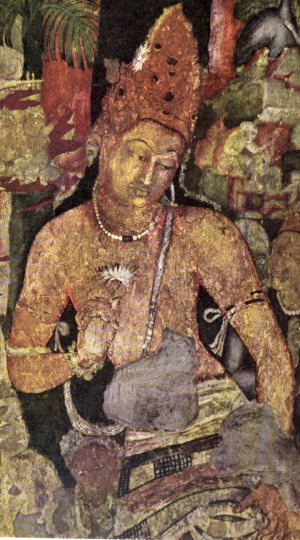Caves of Ajanta and Ellora
First Online: June 02, 2001
Page Last Updated: December 07, 2024
Northeast of Mumbai (a.k.a. Bombay), near Aurangabad, are two astonishing series of temples carved out of living rock (rock formations still in progress) over the course of fourteen centuries. During the 4th century A. D. in a remote valley, work began on the Ajanta caves to create a complex of Buddhist monasteries and prayer halls. As centuries passed, numerous Buddhist monks and artisans dug out a set of twenty-nine caves, converting some to cells, and others to monasteries and Buddhist temples. All of these were carved from the rock cliff at Ajanta. These caves are adorned with elaborate sculptures and paintings which have withstood the ravages of time.
© K. L. Kamat

Bodhisatva -- painting from Ajanta
The sculptures are finely wrought images of animals, guards and deities while the paintings tell ancient tales of courtly life and depict hundreds of Buddhist legends. Amid the beautiful images and paintings are sculptures of Buddha, calm and serene in contemplation.
Work started on the Ellora caves in the seventh century A.D. where another set of caves was created from living rock. Buddhism, Jainism and Hinduism inspired sculptors to create elaborate rock carvings. The Buddhist and Jain caves here are ornately carved, yet seem quiet and meditative, whereas the Hindu caves are filled with a divine energy and power.
The most impressive and majestic creation at Ellora is the Kailasa Temple, a full-sized, freestanding temple flanked by elephants carved out of solid rock during the Rashtrakuta kings. Pillars, podiums, spires and towers combine to produce an awe-inspiring representation of Shiva's Himalayan abode.
![]()
See Also:
- Buddhism Potpourri
- Search for more pictures of Ajanta and Ellora at Kamat PICTURESearch

